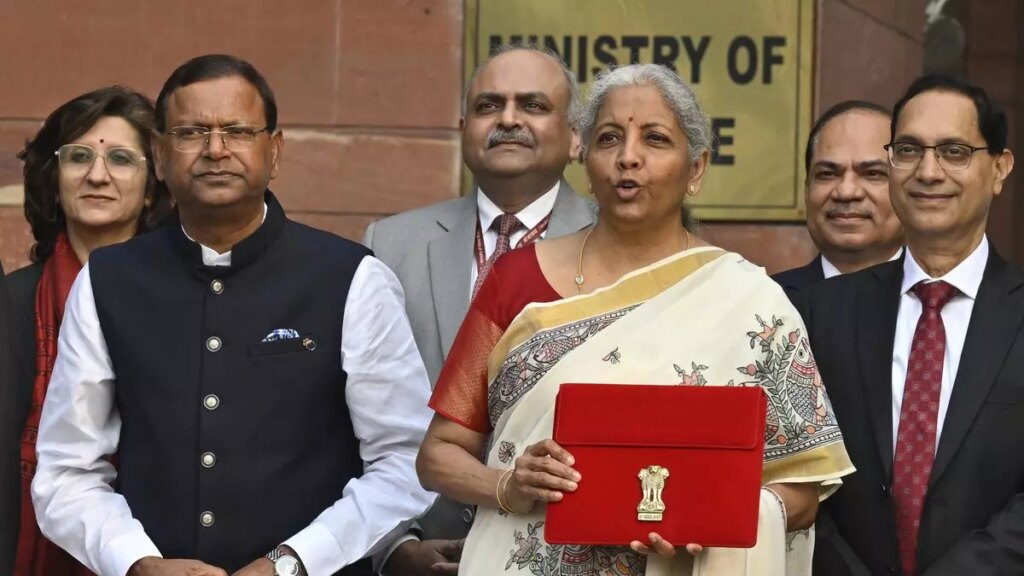Finance Minister Nirmala Sitharaman’s Budget 2025-26 attempts to balance economic priorities with electoral considerations. While it seeks to boost agriculture, infrastructure, and employment, critics argue that the allocations appear politically motivated, particularly with Bihar receiving substantial benefits ahead of election.
Agriculture takes centrestage, with an increased Rs.7 lakh cap on the subsidised Kisan Credit Card loans and targeted programmes for pulses, cotton, and makhana production. The ‘Rural Prosperity and Resilience’ programme aims to curb migration, but questions remain about its execution.
Infrastructure spending rises modestly to Rs.11.2 trillion, though some analysts see it as inadequate given economic challenges. Major projects in Bihar, including new airports and irrigation systems, have drawn scrutiny. The Nuclear Energy Mission aims for 100 GW by 2047, but feasibility concerns linger. The middle class benefits from tax relief, yet skeptics question whether it will meaningfully boost consumption. Defence spending climbs to Rs.6,81,210 crore, prioritising modernisation but leaving some strategic gaps unaddressed.
Markets reacted with caution—consumer-driven sectors gained while infrastructure stocks dipped. With political tensions high, the budget’s effectiveness will depend on its implementation and broader economic conditions.
Agriculture, the growth engine
Agriculture has been placed at the forefront of economic expansion. The Prime Minister Dhan-Dhaanya Krishi Yojana, a flagship initiative, targets 100 low-productivity agricultural districts, aiming to enhance productivity, crop diversification, and post-harvest infrastructure. The government has also raised the subsidised Kisan Credit Card (KCC) loan limit from Rs.5 lakh to Rs.7 lakh to benefit 1.7 crore farmers.
Also Read | Economic Survey 2024-25: Strengthening social sectors for inclusive growth?
A six-year mission will promote self-reliance in pulses production, focusing on tur, urad, and masoor. Cooperatives like Nafed and NCCF will procure pulses for four years under agreements with farmers. The government has also announced a five-year cotton mission to boost productivity and promote extra-long staple cotton varieties. In Bihar, the makhana sector will see dedicated support through a newly established Makhana Board, which will oversee production, processing, and marketing.
To curb rural unemployment, the ‘Rural Prosperity and Resilience’ programme will generate employment opportunities, especially for women, young farmers, marginal farmers, and landless families. The government also plans to formally register India’s growing gig economy workforce and provide access to welfare initiatives, including healthcare.
Infrastructure and manufacturing
The government has announced an investment of Rs.11.2 trillion in capital expenditure, a modest increase from last year. Key allocations include the establishment of new Greenfield airports in Bihar and the expansion of Patna Airport and Bihta’s brownfield airport. The Western Kosi Canal ERM project in Bihar will receive financial support, benefiting over 50,000 hectares of agricultural land. The National Institute of Food Technology, Entrepreneurship, and Management will be established in Bihar to strengthen food processing in Eastern India.
To enhance India’s manufacturing sector, which currently accounts for 17 per cent of GDP, the government will promote startups and encourage innovation through increased funding. The Nuclear Energy Mission aims to drive clean energy adoption, with a target of 100 GW of nuclear power by 2047.
Tax reforms
One of the budget’s key highlights is tax relief for the middle class. The income tax exemption threshold has been raised from Rs 8,074 to Rs 14,800, aiming to boost consumption, savings, and investment. A new tax bill is expected next week to simplify taxation further. These measures have been well-received by salaried professionals but criticised by opposition leaders who argue that employment generation remains unaddressed.
The government has allocated Rs.6,81,210 crore for defence, a 9.5 per cent increase from the previous year. Of this, Rs.1,92,387 crore is earmarked for capital outlay, including Rs.48,614 crore for aircraft and aero engines, Rs.24,390 crore for the naval fleet, and Rs.63,099 crore for other equipment.
Tech and AI
The budget allocates Rs.500 crore to establish a Centre of Excellence in AI for Education while introducing AI-focused initiatives across sectors. The Deep Tech Fund includes provisions for AI startups, particularly in healthcare diagnostics, agricultural forecasting, and manufacturing automation. State governments receive funding to implement AI-based solutions for urban planning and public service delivery. The policy framework encourages AI research collaboration between academic institutions and industry, with dedicated funding for hardware infrastructure and computing resources. New guidelines address AI governance, focusing on data privacy, algorithmic transparency, and ethical deployment across public institutions.
Market reactions
Stock markets reacted with mixed sentiments. Infrastructure stocks, including Larsen & Toubro, PNC Infra, and NBCC, fell due to modest capital expenditure growth. However, consumer-focused sectors benefitted from tax relief, with FMCG, auto, and realty stocks gaining. The extension of the water supply enhancement scheme and increased urea supply bolstered fertiliser and pipe-making companies.
Also Read | Modi 3.0’s first Union Budget bears the unmistakable stamp of coalition politics
The budget has sparked political debates, particularly over its perceived favouritism toward Bihar, where the election is due. Congress MP Jairam Ramesh criticised the government for sidelining Andhra Pradesh despite the State’s importance to the ruling NDA. Congress leaders have called the budget “directionless” and accused the government of electoral gimmickry, while DMK MP Dayanidhi Maran described the tax reforms as “confusing.”
Conclusion
Budget 2025-26 presents a mix of growth-oriented policies and strategic electoral positioning. While tax relief, agriculture, and employment schemes indicate a focus on economic expansion, political considerations are evident in sectoral allocations. Whether this budget will translate into sustainable growth or remain a pre-election exercise will depend on implementation and broader economic conditions.
With inputs from agencies
Source:https://frontline.thehindu.com/news/budget-2025-analysis-tax-cuts-agriculture-infrastructure-rural-india-health-tech-election/article69167937.ece

